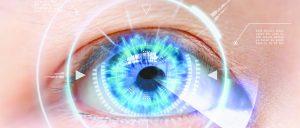 People depend on their eyes to last a lifetime, and the Board-certified ophthalmologists of Lake Eye Associates are ready to assist with answers about a few disorders that become more common as everyone gets older.
People depend on their eyes to last a lifetime, and the Board-certified ophthalmologists of Lake Eye Associates are ready to assist with answers about a few disorders that become more common as everyone gets older.
What Care is Needed for Aging Eyes?
Once you reach age 60, it is highly recommended that you schedule annual comprehensive eye exams with your ophthalmologist. Why? Because with regular care, nearly all eye diseases and disorders can be prevented, corrected or arrested.
Glaucoma is a group of diseases that damage the optic nerve, leading to vision loss and even blindness if left untreated. Early detection is the key to protecting vision. “Glaucoma testing is part of a completely painless comprehensive eye exam,” says Dr. Mark Vocci, “which looks for a range of eye diseases that can almost always be managed or eliminated when caught in time.”
Age-related macular degeneration, or AMD, refers to deterioration of the macula, the area of the retina that lets you see fine details needed for reading or driving. Testing can catch AMD early before it causes serious damage.
Dry eye is another common complaint. Most cases of severe dry eye are caused by a disorder called Meibomian Gland Dysfunction (MGD), which occurs when the glands that lubricate the eye become blocked. MGD may limit the effectiveness of treatments like eye drops, so diagnosis is important. Lake Eye utilizes a non-invasive, drug-free therapy for MGD that, by gently massaging blocked glands, helps to clear them, naturally restoring moisture to the eye.
Diabetic retinopathy occurs when high blood sugar levels damage blood vessels in the retina. Background retinopathy is characterized by weak or leaking blood vessels, and proliferative retinopathy describes the proliferation of these fragile new vessels. In both types, the bleeding damages vision, but luckily diabetic retinopathy can be treated with medication and/or procedures designed to stop or limit its course.
Will I Need Cataract Surgery?
“Nearly everybody gets cataracts at some point,” says Dr. Scott Wehrly. “Fortunately, advances in technology and our personal commitment to state-of-the-art cataract treatment mean we can quickly and safely remove cataracts in just minutes, and provide vision correction that reduces or even eliminates a person’s need for glasses.”
“Our team of doctors heavily researches all emerging and promising technologies,” says Dr. Scot Holman. “We regularly consult with respected peers from all over the world about eye disorders, including cataracts, so we can always remain at the forefront of the latest advances in care.”
Cataract surgery is a roughly 10-minute outpatient surgery in which your ophthalmologist gently removes the affected lens. Lake Eye’s surgeons use the state-of-the-art CATALYS Femtosecond Laser for exceptionally safe, fast and precise cataract removal. The lens is then replaced with an intraocular lens, or IOL, which can help correct astigmatism, improve multiple vision ranges, and even restore clear vision at all distances in some patients. The best lens technology for each patient is determined through a series of sophisticated diagnostic examinations combined with the patient’s input to help maximize long-term satisfaction. “I explain the procedure in detail, ask about their expectations, and get them excited about seeing better,” says Dr. Vinay Gutti.
Lake Eye Associates
352-750-2020
Check Also
Recurrent UTIs: Addressing the Risk of Antibiotic Resistance
Urinary tract infections (UTIs) are common bacterial infections that affect millions of individuals worldwide each …
 Central Florida Health and Wellness Magazine Health and Wellness Articles of the Villages
Central Florida Health and Wellness Magazine Health and Wellness Articles of the Villages



